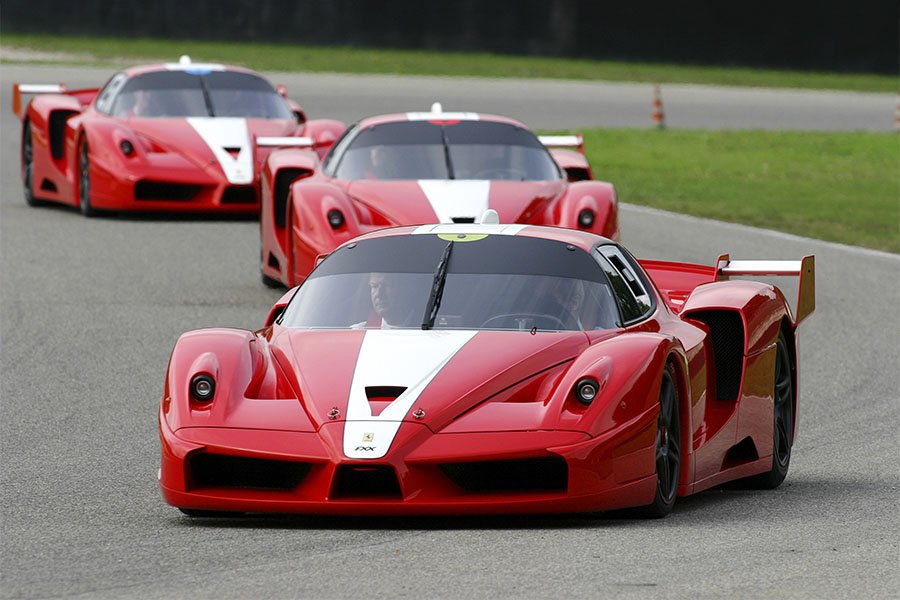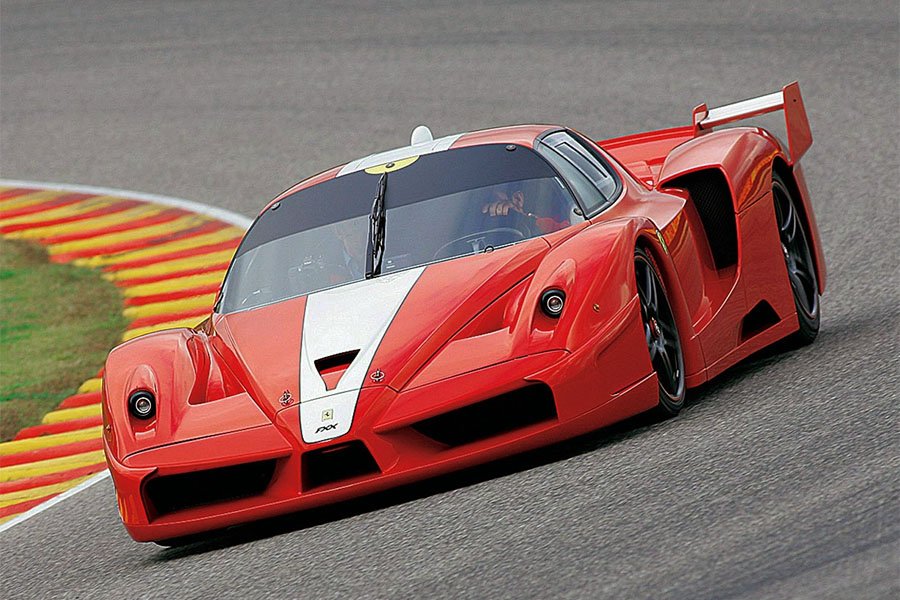Guide: Ferrari FXX - a Historical & Technical Appraisal
/BACKGROUND
At the Paris Motor Show in September 2002, Ferrari unveiled its fourth generation mid-engined limited edition flagship: the Enzo.
Created as a successor to the legendary 288 GTO, F40 and F50, the Enzo was offered exclusively to Ferrari’s VIP customers and ultimately proved so popular that the original run of 349 cars had to be increased to around the 500 mark.
Unfortunately, despite a specification that could have made it a world beater in GT racing, a competition version of the Enzo never made it to fruition. Well, not with a Ferrari badge...
Instead, it was decided that for marketing purposes, a GT1 machine based on Enzo underpinnings would better serve Maserati which Ferrari had taken full control of in 1999 (having initially acquired a 50% stake from Fiat in 1997).
50 examples of the resultant Maserati MC12 road car were built in two batches between 2004 and 2005; the initial run of 25 cars was followed by a second group to satisfy demand. In racing, the MC12 GT1 went on to become the dominant platform for five seasons.
With the Enzo and MC12 having both been heavily over-subscribed, Ferrari decided there was a gap in the market for a track-only Enzo aimed at its wealthiest and most passionate customers.
The resultant FXX (the Enzo had been codenamed FX) was announced on the Ferrari Owners website in June 2005. A physical launch then took place during August at the Pebble Beach Concours d’Elegance followed by an on-track debut at the Mugello Finali Mondiali in October.
Dubbed the most advanced GT ever created at Maranello, a production run of ‘20 or so’ customer cars was mooted, none of which would be homologated for either road or competition use.
Instead, each customer would get to use their car at a series of XX international-level track events organised by Ferrari throughout 2006 and 2007. On these occasions, an official team of technicians was on hand to provide all the assistance required.
Throughout the two-year XX programme, each FXX was kept at Maranello and the cars were initially only permitted for use at approved Ferrari events (to include private sessions).
In addition to the car, test programme, maintenance and travel logistics, each FXX customer received a Fiorano driving course for their €1.5m pre-tax acquisition.
Following completion of the prototype, the first customer cars rolled out of Maranello in December 2005.
ENGINE / TRANSMISSION
Instead of the Enzo’s Tipo F140 B engine, the FXX was equipped with an enlarged and substantially more powerful Tipo F140 DA unit.
Another longitudinally-mounted 65° V12, the F140 DA had its bore increased from 92mm to 94mm while stroke was kept at 75.2mm. The result was a displacement of 6262cc which represented a 264cc gain over the 5998cc original.
A new de-restricted exhaust system was installed and the compression ratio was hiked from 11.2:1 to 13.4:1.
The existing Bosch Motronic ME7 management software was re-mapped to suit the new engine’s characteristics. It controlled the PFI multiple injection system, the drive-by-wire throttle valve and the single coil on each spark plug.
As per the Enzo, the FXX power unit employed an alloy block and heads, titanium connecting rods, a lightweight crankshaft and ‘pentroof-type’ combustion chambers with four-valves per cylinder. Chain-driven timing gear employed dual overhead camshafts, direct valve control and hydraulic tappets. The timing of the inlet and exhaust manifolds was continuously variable.
Lubrication was via a dry-sump system.
A variable length induction system extended the length of the induction pipes via hydraulic actuators.
Peak output was 800bhp at 8500rpm and 506lb-ft at 5750rpm.
For comparison, the Enzo pumped out 650bhp at 7800rpm and 485lb-ft at 5500rpm.
Transmission was through a rear-mounted six-speed F1 gearbox coupled directly to the engine by an element that incorporated the engine oil tank, the bevel gear pair and the self-locking limited-slip differential. The clutch was a twin-plate electro-hydraulic unit.
Gear shifts had to be carried out manually via carbonfibre paddles mounted behind the steering wheel. Whereas the Enzo had a fastest possible shift time of 150 milliseconds, thanks to adoption of the latest F1 technology, this was cut to just 80 milliseconds in the FXX.
Each different drive mode came with its own integrated software map that controlled the traction control system.
CHASSIS
As per the Enzo, the FXX was built around a carbonfibre monocoque with aluminium honeycomb sandwiched in between.
Ferrari mounted the engine on a special cast alloy subframe as opposed to directly onto the monocoque. The roof was bonded to the tub. The wheelbase measured 2650mm.
Race-derived double wishbone suspension employed adjustable pushrod-actuated coil / damper units mounted to the tub at the front and to the subframe at the rear. The continuously adaptive Skyhook dampers fitted to the Enzo were dropped in favour of conventional dampers that gave a 20mm lower ride height. An anti-roll bar was fitted at either end.
Air jacks were exclusive to the FXX.
Larger versions of the Enzo’s Brembo carbon ceramic brake discs were installed along with uprated pads. Brake cooling was much-improved. A six and four-piston caliper arrangement was retained front-to-rear respectively.
The Enzo’s centre-lock 19-inch diameter wheels were carried over (9-inches wide front, 13 rear) but now came shod with specially developed Bridgestone racing tyres.
Two competition-grade fuel cells were located either side of the engine up against the rear bulkhead. Overall capacity was increased from 110 to 112-litres.
Thanks to extensive data-monitoring and telemetry systems that gave real-time feedback on 39 different parameters, drivers were able to have their performance directly assessed by Ferrari’s on-site technicians.
BODYWORK
Although its Enzo DNA was clearly evident, the FXX came with a host of bodywork refinements that resulted in an even more aggressive appearance.
At the front was an extended front apron with more pronounced central nose section, re-shaped intake ducts and new side-mounted cooling vents. Further up were exposed single beam projector headlamps and repositioned side blinkers.
The front lid incorporated a pronounced delta-shaped bulge carved out from the leading edge of which was a large NACA duct.
To improve airflow, a vertical windscreen wiper replaced the original leaning set-up. Sliding Plexiglas side windows were installed instead of the Enzo’s conventional type. At the back of the roof was a blister that housed a receiver for pit-to-car telemetry. An exposed competition-style fuel filler cap was located on the left-hand sail panel.
Towards the back, the FXX featured a bank of five vents cut from the top of each rear fender. There was also a new adjustable rear spoiler assembly with high-rise outboard sections and a low-line central plane.
The tail fascia was completely re-modelled with the exhausts re-routed to exit where the Enzo’s lights normally resided. There were also massive new cutaways to improve cooling. New LED lights were moved down to the lower side vents. Underneath was an enormous body coloured venturi.
Other new details included body coloured skirts, fastening pins for the front lid and a tow hook located in the central nose aperture.
Overall, the FXX was 130mm longer, 5mm wider and generated 40% more downforce than the Enzo.
INTERIOR
Inside, the FXX was pared back to save as much weight as possible.
The original leather trimmed buckets were replaced with Sparco racing seats upholstered in fire-proof black fabric. Conventional seatbelts were switched to racing harnesses.
Other safety equipment included a fully integrated rollcage and fire system. The passenger airbag was deleted.
The Enzo-type steering wheel came with an alcantara rim and exposed carbonfibre boss. Behind was a new digital dash with exposed carbonfibre fascia. A dash-mounted rear view camera replaced the Enzo’s conventional mirror.
A reconfigured centre console housed controls for the aero pack (automatic or settings 1 to 3 for low to high downforce), an electric on / off switch, a starter button, a red fire extinguisher button and an electrical cut-off switch. Located on the central tunnel was the fire system control box.
Simplified door panels and a basic ventilation system saved a few more pounds.
Air jacks protruded into the sides of the footwells.
Seat and pedal positions were tailored to each customer.
OPTIONS
In addition to a choice of body and wheel colours, customers could request a passenger seat and Enzo wing mirrors.
WEIGHT / PERFORMANCE
At 1155kg, the FXX weighed 100kg less than an Enzo.
The 0-62mph time dropped from 3.1 to 2.7 seconds.
As a consequence of its high downforce body, top speed dropped from 217mph to 214mph.
FXX PRODUCTION
The first FXX customer cars were completed in December 2005.
30 were built (in addition to the prototype) of which eight were sold to customers from the USA, five to Germany, four to Japan, four to Switzerland, two to the UK, two to Italy, two to Canada, one to Sweden, one to the Netherlands and one to Saudi Arabia.
Two cars were finished with Nero paint with one each in Giallo, Azzuro California, Bianco Fuji, Grigio Nurburgring and Blu Tour de France. The remainder were a combination of Rosso Corsa and Rosso Scuderia.
The last example (completed out of sequence to the rest of the production run) was presented to Michael Schumacher at the Nurburgring XX event in September 2006 to mark his impending retirement from Formula 1.
Uniquely, Schumacher’s Nero FXX (chassis 149546 which wore number 30) was completed without the normal white centre stripe, spoiler accents and FXX spoiler branding. It also featured matt instead of chrome exhausts tips. Elsewhere, Schumacher’s red MS script was applied to the side of the tub and stitched into the seat bases.
FXX EVOLUZIONE
At the Suzuka XX event in July 2007, Ferrari announced an Evoluzione kit would be available by the end of the year. Full details were then published in October.
For an additional €1.5m, customers could have their car uprated to Evoluzione trim and experience another two years of the XX programme.
Thanks to re-mapped engine management, peak output was now 848bhp at 9500rpm and 508lb-ft at 5750rpm (up from 800bhp at 8500rpm and 506lb-ft at 5750rpm respectively).
Uprated gearbox software was also installed which cut shift times from 80 milliseconds to just 60.
Gear ratios were revised to suit the engine’s 1000rpm higher redline.
An improved traction control system now offered the driver a choice of nine different settings.
A new telemetry system now monitored the steering angle and brake pump pressure in addition to the existing parameters.
Externally, a revised aero pack was said to be 25% more efficient than the original set-up. It included an active front spoiler, new rear spoiler flaps and an updated rear diffuser. There was also a new stripe kit.
The Bridgestone tyres and Brembo brake pads were switched for long-life items that lasted around twice as long as before.
Customers could optionally request two additional in-car cameras to complement the existing rear-facing unit.
Top speed went from 214mph to 218mph while the 0-62mph time dropped from 2.77 seconds to just 2.5. The Evoluzione was also two seconds per lap faster around Ferrari’s Fiorano test track than the original FXX.
Weight was an unchanged 1155kg.
FXX EVOLUZIONE PRODUCTION
Most of the existing FXXs were uprated to Evoluzione trim, in addition to which Ferrari manufactured three brand new cars taking total FXX production to 34 units.
Text copyright: Supercar Nostalgia
Photo copyright: Ferrari - https://www.ferrari.com










































